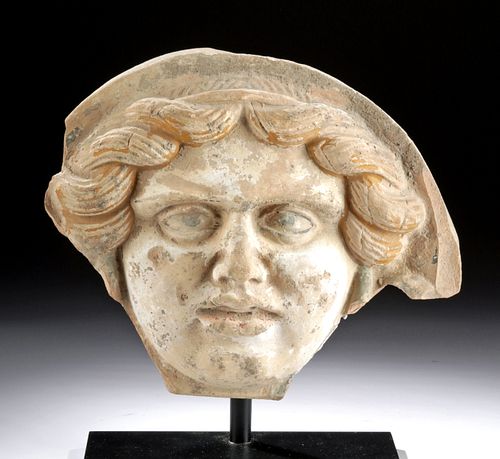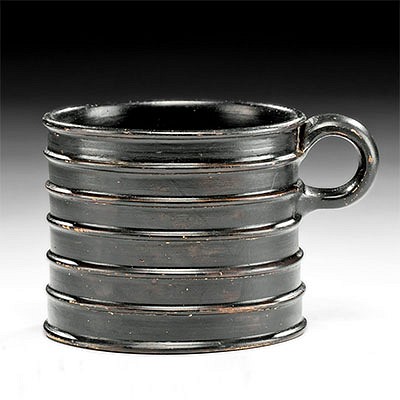Greek Tarentum Polychrome Medusa Antefix w/ TL Report
Lot 26c
About Seller
Artemis Gallery
686 S Taylor Ave, Ste 106
Louisville, CO 80027
United States
Selling antiquities, ancient and ethnographic art online since 1993, Artemis Gallery specializes in Classical Antiquities (Egyptian, Greek, Roman, Near Eastern), Asian, Pre-Columbian, African / Tribal / Oceanographic art. Our extensive inventory includes pottery, stone, metal, wood, glass and textil...Read more
Categories
Estimate:
$5,500 - $8,250
Absentee vs Live bid
Two ways to bid:
- Leave a max absentee bid and the platform will bid on your behalf up to your maximum bid during the live auction.
- Bid live during the auction and your bids will be submitted real-time to the auctioneer.
Bid Increments
| Price | Bid Increment |
|---|---|
| $0 | $25 |
| $300 | $50 |
| $1,000 | $100 |
| $2,000 | $250 |
| $5,000 | $500 |
| $10,000 | $1,000 |
| $20,000 | $2,500 |
| $50,000 | $5,000 |
| $100,000 | $10,000 |
| $200,000 | $20,000 |
About Auction
By Artemis Gallery
Mar 12, 2020
Set Reminder
2020-03-12 10:00:00
2020-03-12 10:00:00
America/New_York
Bidsquare
Bidsquare : Ancient / Ethnographic Around The World
https://www.bidsquare.com/auctions/artemis-gallery/ancient-ethnographic-around-the-world-4957
Ancient art from Egypt, Greece, Italy and the Near East, as well as Asian, Fossils, Pre-Columbian, Native American, African / Tribal / Oceanic, Spanish Colonial, Russian Icons, Fine art, much more! Artemis Gallery info@artemisgallery.com
Ancient art from Egypt, Greece, Italy and the Near East, as well as Asian, Fossils, Pre-Columbian, Native American, African / Tribal / Oceanic, Spanish Colonial, Russian Icons, Fine art, much more! Artemis Gallery info@artemisgallery.com
- Lot Description
Ancient Greece, Tarentum, Classic Period, ca. 2nd half of the 5th century BCE. A superb mold-formed terracotta antefix with a semicircular top rim, a slightly concave verso, and the obverse with a high relief depiction of Medusa, the most famous of the three snake-haired gorgon sisters. Medusa's stern countenance stares out at the viewer with piercing, black-rimmed eyes beneath furrowed brows, a bulbous nose flanked with deep nasolabial folds, full lips, puffy cheeks, and a rounded chin, all set beneath a centrally-parted coiffure with finely delineated strands of hair. Thick traces of white pigment envelop the face, with red pigment adorning the lips and eye canthi, blue on the pupils and earrings, and orange-yellow pigment for the auburn hair. An attractive example of architectural artistry from ancient Greece! Size: 9.5" W x 7.75" H (24.1 cm x 19.7 cm); 9.3" H (23.6 cm) on included custom stand.
Roof tiles that ran along the eaves of ancient Greek and Etruscan buildings often ended in upright, painted, mold-made terracotta members called antefixes which usually took the form of either human or mythological heads. These antefixes had three functions. First, they concealed the termini of convex tiles and thus protected them from bad weather. In addition, they were part of the architectural decoration. Finally, these visages were believed to possess an apotropaic role, fending off evil and bad luck from temples.
Medusa was the most famous of the three gorgons, human women with venomous snakes for hair. The concept of the gorgon, a frightening, beast-like, female creature, is at least as old as Homer and continued to be used as a monstrous symbol throughout the Roman period, especially popular as decoration on pottery. Here she is depicted as more beautiful than usual, with large, striking eyes that stare straight forward as you gaze upon her and her murderous locks.
A stylistically-similar example, of a smaller size and with only white slip pigment, hammered for $9,400 at Christie's, New York "Antiquities" auction (sale 9666, June 8, 2001, lot 175).
This piece has been tested using thermoluminescence (TL) analysis and has been found to be ancient and of the period stated. A full report will accompany purchase.
Provenance: private East Coast, USA collection; ex-Aphrodite Gallery auction, New York, New York, USA (November 2018); ex-private Mr. W. collection, Switzerland, acquired in 1980
All items legal to buy/sell under U.S. Statute covering cultural patrimony Code 2600, CHAPTER 14, and are guaranteed to be as described or your money back.
A Certificate of Authenticity will accompany all winning bids.
We ship worldwide and handle all shipping in-house for your convenience.
#149171Losses to areas of periphery and bottom as shown. Nicks and minor abrasions to cheeks, nose, brows, coiffure, peripheries, and verso, with a few small excisions, fading and chipping to original pigmentation, and softening to some finer details. Nice earthen deposits and fabulous traces of original pigment throughout. Old inventory label on verso. Mounted with modern metal loop-ended screw on verso for display purposes. Two TL drill holes on verso: one on top, and one on bottom.Condition
- Shipping Info
-
All shipping is handled in-house for your convenience. Your invoice from Artemis Gallery will include shipping calculation instructions. If in doubt, please inquire BEFORE bidding for estimated shipping costs for individual items.
-
- Buyer's Premium



 EUR
EUR CAD
CAD AUD
AUD GBP
GBP MXN
MXN HKD
HKD CNY
CNY MYR
MYR SEK
SEK SGD
SGD CHF
CHF THB
THB














